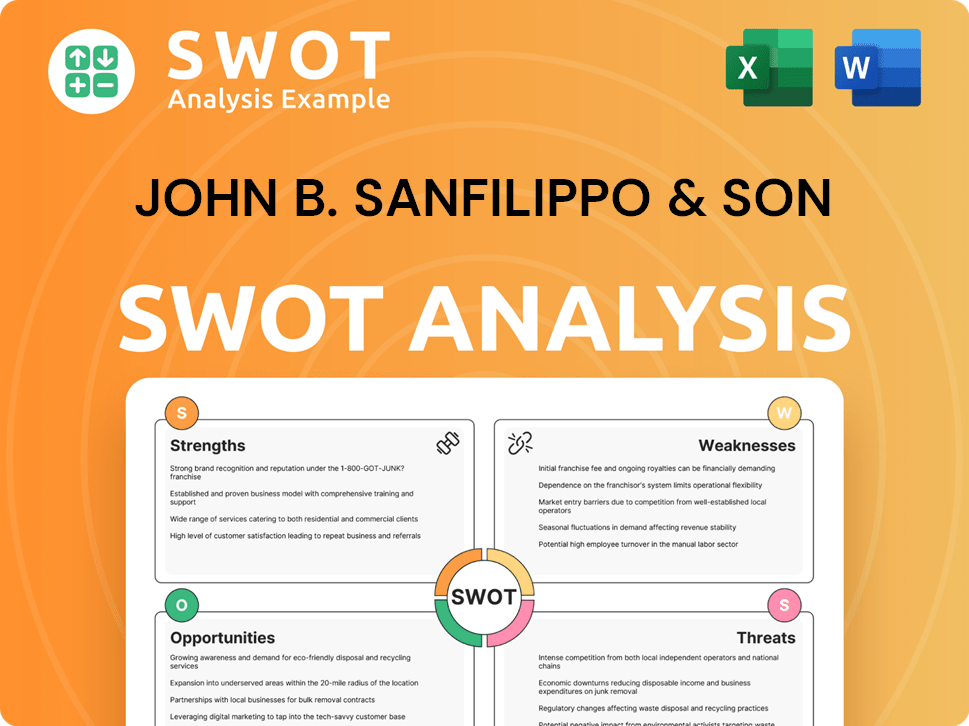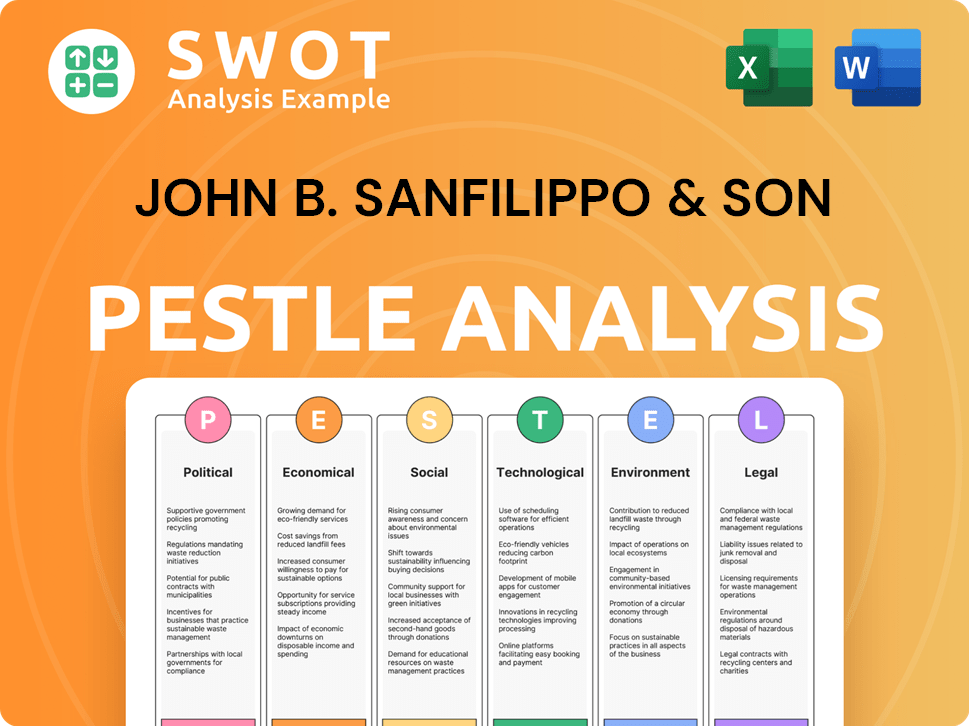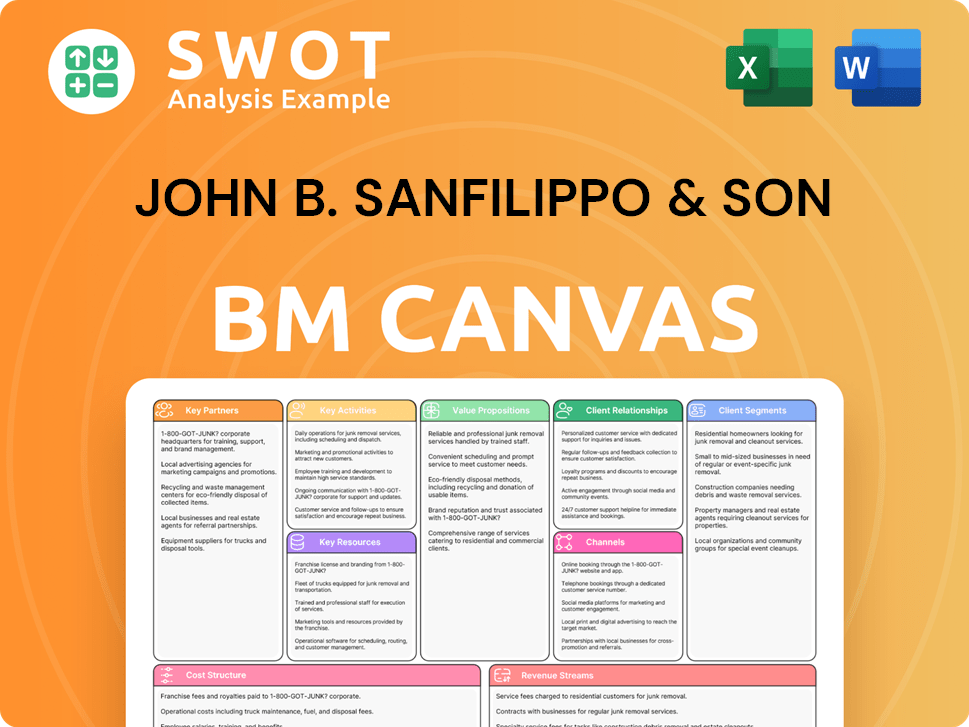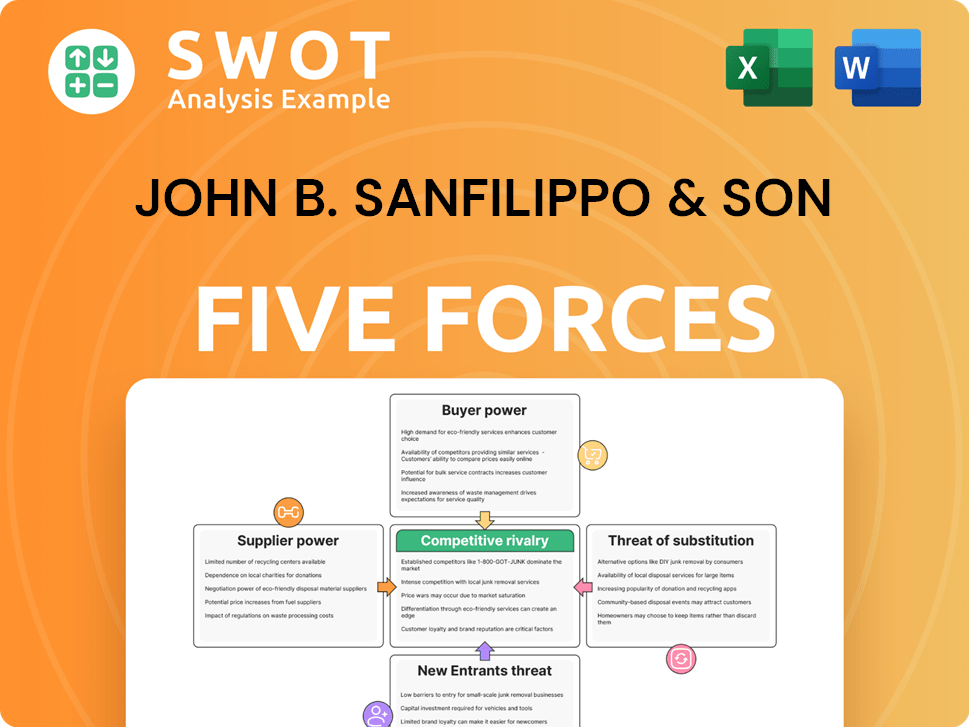John B. Sanfilippo & Son Bundle
How Does John B. Sanfilippo & Son Dominate the Nut Industry?
Dive into the dynamic world of John B. Sanfilippo & Son, a company that has masterfully transformed from a bulk supplier to a consumer-facing powerhouse in the John B. Sanfilippo & Son SWOT Analysis. This article unveils the secrets behind their successful sales and marketing strategies, examining how they've built iconic brands like Fisher and Orchard Valley Harvest. Learn how they've navigated the competitive landscape of the nut industry and achieved impressive sales performance.

From its humble beginnings in 1922, John B. Sanfilippo & Son has strategically evolved its sales strategy and marketing strategy to meet changing consumer demands. This evolution is evident in their robust distribution strategy and innovative marketing campaigns. Understanding their approach provides invaluable insights into brand marketing within the consumer packaged goods sector. This analysis will also explore how they target their audience and maintain their market share.
How Does John B. Sanfilippo & Son Reach Its Customers?
The sales strategy employed by John B. Sanfilippo & Son, Inc. (JBSS) centers on a robust, multi-channel distribution network designed to maximize market reach for its nut and dried fruit products. This approach includes a strong emphasis on traditional brick-and-mortar retail, complemented by a growing presence in the e-commerce space. The company's ability to adapt and optimize its distribution channels is crucial for maintaining its competitive edge within the consumer packaged goods (CPG) sector.
JBSS's marketing strategy is closely intertwined with its sales channels, ensuring that products are not only available but also effectively presented to consumers. The company's brand marketing efforts, including its own brands like Fisher and Orchard Valley Harvest, are supported by strategic partnerships with major retailers. These partnerships provide significant shelf space and visibility, crucial for driving sales and building brand recognition within the nut industry. The company's distribution strategy is a key factor in its overall financial performance.
The company's distribution strategy has been instrumental in its financial success. In its fiscal year ending May 2024, JBSS reported net sales of approximately $1.3 billion. This sales performance reflects the effectiveness of its expansive distribution network and its ability to meet consumer demand across various retail formats. JBSS's commitment to a diversified sales approach has consistently supported its market share and overall growth.
JBSS products are widely available in supermarkets, mass merchandise stores, club stores, convenience stores, and drug stores. These offline channels are essential for reaching a broad consumer base. The company's established relationships with major retailers are key to its distribution model.
JBSS has embraced online channels to meet the growing demand for e-commerce. Products are available on major e-commerce platforms. The company likely uses its online presence to enhance brand visibility and drive sales.
JBSS extends its reach through wholesale distributors, particularly to smaller independent retailers. This strategy helps to ensure product availability across a wide range of retail outlets. This approach supports overall sales performance.
Key partnerships and exclusive distribution deals with large retail chains contribute significantly to JBSS's market share and consistent growth. These partnerships provide shelf space and visibility. These deals are important for the company's marketing strategy.
JBSS's sales strategy focuses on a multi-channel approach, leveraging both offline and online platforms. The company's distribution strategy is designed to reach a broad consumer base. This strategy is a key factor in its success within the nut industry.
- Emphasis on major retail partnerships for shelf space and visibility.
- Adaptation to changing retail landscapes, including e-commerce growth.
- Optimized product assortments for different retail formats.
- Strategic use of wholesale distributors to extend market reach.
John B. Sanfilippo & Son SWOT Analysis
- Complete SWOT Breakdown
- Fully Customizable
- Editable in Excel & Word
- Professional Formatting
- Investor-Ready Format

What Marketing Tactics Does John B. Sanfilippo & Son Use?
The company, a key player in the nut industry, employs a robust marketing strategy to boost sales and maintain a strong market presence. Their approach encompasses a blend of digital and traditional marketing tactics, carefully designed to reach a wide consumer base. This comprehensive strategy supports the company's overall sales strategy, driving demand for its diverse product line.
The marketing tactics of the company are multifaceted, incorporating digital marketing, traditional advertising, and strategic partnerships. They focus on building brand awareness and engaging consumers through various channels. This integrated approach is crucial for success in the competitive consumer packaged goods (CPG) market.
The company's marketing efforts are data-driven, with a focus on understanding consumer behavior and market trends. This allows for tailored messaging and product development, enhancing the effectiveness of their marketing campaigns. The company continuously refines its strategies to adapt to changing consumer preferences and market dynamics.
The company leverages content marketing, creating recipes and promoting healthy snacking ideas. They utilize SEO and paid advertising on platforms like Google and social media. Email marketing is also used for direct-to-consumer engagement, offering promotions and new product announcements.
They collaborate with food bloggers and health and wellness advocates. This strategy helps reach specific demographics and build authentic brand connections. These partnerships are key to expanding brand reach and influence.
Social media platforms, including Facebook, Instagram, and Pinterest, are essential for visual storytelling. They use these platforms for community engagement and promoting product versatility. The company's social media presence is crucial for brand visibility.
Historically, the company has utilized TV, radio, and print advertising. They use these channels to reach broad audiences, especially for the flagship brand. This approach supports a comprehensive brand marketing strategy.
Participation in industry events and trade shows is a key strategy. This strengthens B2B relationships and showcases new product innovations. These events are crucial for networking and market presence.
The company analyzes sales data, consumer demographics, and market trends. This informs product development, pricing strategies, and promotional activities. Customer segmentation and personalization are also used.
The company's marketing strategies are designed to boost sales performance in the nut industry. They focus on building brand awareness, engaging consumers, and leveraging data to refine their approach. The company's marketing efforts are crucial for maintaining its market share and driving revenue growth.
- Digital Marketing: Content marketing, SEO, paid advertising, and email marketing are used to reach consumers online.
- Influencer Marketing: Partnerships with food bloggers and health advocates are key.
- Social Media Engagement: Platforms like Facebook, Instagram, and Pinterest are used for visual storytelling and community building.
- Traditional Advertising: TV, radio, and print are used to reach broad audiences.
- Data Analysis: Sales data, consumer demographics, and market trends inform product development and pricing.
For a deeper understanding of the company's target market, further insights can be found in the Target Market of John B. Sanfilippo & Son article.
John B. Sanfilippo & Son PESTLE Analysis
- Covers All 6 PESTLE Categories
- No Research Needed – Save Hours of Work
- Built by Experts, Trusted by Consultants
- Instant Download, Ready to Use
- 100% Editable, Fully Customizable

How Is John B. Sanfilippo & Son Positioned in the Market?
The company strategically positions its brands to capture different consumer segments within the competitive nut and dried fruit market. This approach is a key element of its overall sales strategy and marketing strategy. By differentiating its brands, the company aims to maximize market penetration and cater to diverse consumer preferences. This multi-brand strategy allows the company to address various price points, health considerations, and taste profiles, thereby broadening its appeal within the nut industry and the broader consumer packaged goods sector.
This brand architecture includes Fisher, Orchard Valley Harvest, and Squirrel Brand, each targeting specific consumer needs and preferences. Fisher focuses on tradition and everyday value, Orchard Valley Harvest emphasizes health and wellness, and Squirrel Brand caters to consumers seeking premium, gourmet experiences. The company's ability to effectively position each brand is crucial for its brand marketing efforts and overall success. This strategic approach is vital for maintaining and growing its market share.
The company's brands are carefully positioned to resonate with specific consumer groups, enhancing its sales performance. Fisher emphasizes heritage and quality, appealing to consumers looking for trusted baking ingredients and snacking nuts. Orchard Valley Harvest highlights natural and wholesome ingredients for health-conscious consumers. Squirrel Brand targets those seeking premium snacking experiences. This targeted approach is a core part of its marketing strategies for nut brands.
Fisher emphasizes tradition and reliability, appealing to consumers seeking familiar and trusted products. It focuses on everyday value and versatility in both home cooking and snacking. The brand's messaging often highlights its long-standing presence and commitment to quality, resonating with consumers who value consistency and dependability.
Orchard Valley Harvest is positioned as a health-conscious option, focusing on natural and wholesome ingredients. It appeals to consumers who prioritize health and wellness, often highlighting non-GMO or organic attributes. The brand's visual identity and tone of voice reflect freshness and natural goodness, aligning with current health trends.
Squirrel Brand targets consumers looking for premium and indulgent snacking experiences. It emphasizes unique flavors and high-quality ingredients, often conveying sophistication and an upscale appeal. This brand caters to those seeking a more luxurious snacking experience, differentiating itself through its gourmet offerings.
The company appeals to its target audience through a combination of value, quality, and specific lifestyle alignments. Fisher offers everyday value and reliability, Orchard Valley Harvest provides a perceived premium for health benefits, and Squirrel Brand delivers a luxury snacking experience. This multi-faceted approach helps the company maintain its competitive edge.
The company maintains brand consistency across all channels, from packaging to digital content, ensuring a cohesive brand narrative. It actively monitors consumer sentiment and competitive threats, adapting its messaging and product offerings to remain relevant. The company’s focus on John B Sanfilippo & Son is evident in its strategic brand positioning, designed to meet evolving consumer demands.
- Consistent branding across all touchpoints.
- Adaptation to changing consumer preferences.
- Focus on health and wellness trends.
- Emphasis on premium and gourmet offerings.
John B. Sanfilippo & Son Business Model Canvas
- Complete 9-Block Business Model Canvas
- Effortlessly Communicate Your Business Strategy
- Investor-Ready BMC Format
- 100% Editable and Customizable
- Clear and Structured Layout

What Are John B. Sanfilippo & Son’s Most Notable Campaigns?
The sales and marketing strategy of John B. Sanfilippo & Son, Inc. (JBS) is multifaceted, encompassing various brands and targeting different consumer segments within the nut industry. A key aspect of their approach involves tailoring marketing efforts to the specific characteristics of each brand, ensuring a targeted and effective reach. This strategy has contributed to JBS's sustained growth and market presence, reflecting the effectiveness of its integrated sales and marketing strategies.
Marketing campaigns are designed to enhance brand recognition and drive sales across different product categories. The company leverages a mix of traditional and digital marketing channels. This includes television, print, social media, and partnerships with influencers, to reach a broad audience and specific demographics. The primary goal is to maintain brand loyalty and increase consumer engagement, which is crucial in the competitive consumer packaged goods market.
The company's overall net sales reached $1.3 billion in fiscal year 2024, showcasing the efficacy of their integrated sales and marketing strategies. This financial performance underscores the importance of their strategic brand-specific campaigns and their ability to adapt to evolving market trends. For more insights into the business model and revenue streams of JBS, explore Revenue Streams & Business Model of John B. Sanfilippo & Son.
Campaigns for the Fisher brand often focus on versatility in baking and snacking. They utilize traditional media like television and print to target a broad household audience. The goal is to reinforce Fisher's position as a pantry staple and a trusted ingredient for home cooks. These campaigns help maintain brand loyalty.
Orchard Valley Harvest campaigns highlight the health and wellness aspects of its products. They target health-conscious consumers through digital channels and partnerships with influencers. The creative concepts often emphasize the nutritional benefits of dried fruits and nuts. This strategy aims to increase brand awareness and trial among this demographic.
Squirrel Brand campaigns focus on its gourmet appeal, using niche digital platforms and collaborations with food connoisseurs. They highlight the premium quality and unique flavor profiles of the products. The objective is to drive sales in the specialty and premium snack categories and enhance brand perception as an indulgent treat.
The success of these campaigns is typically measured by sales lift in product categories and increased brand recognition. Consumer engagement metrics online are also critical. The company monitors these metrics to ensure their marketing efforts are effective and aligned with their objectives in the nut industry.
John B. Sanfilippo & Son Porter's Five Forces Analysis
- Covers All 5 Competitive Forces in Detail
- Structured for Consultants, Students, and Founders
- 100% Editable in Microsoft Word & Excel
- Instant Digital Download – Use Immediately
- Compatible with Mac & PC – Fully Unlocked

Related Blogs
- What are Mission Vision & Core Values of John B. Sanfilippo & Son Company?
- What is Competitive Landscape of John B. Sanfilippo & Son Company?
- What is Growth Strategy and Future Prospects of John B. Sanfilippo & Son Company?
- How Does John B. Sanfilippo & Son Company Work?
- What is Brief History of John B. Sanfilippo & Son Company?
- Who Owns John B. Sanfilippo & Son Company?
- What is Customer Demographics and Target Market of John B. Sanfilippo & Son Company?
Disclaimer
All information, articles, and product details provided on this website are for general informational and educational purposes only. We do not claim any ownership over, nor do we intend to infringe upon, any trademarks, copyrights, logos, brand names, or other intellectual property mentioned or depicted on this site. Such intellectual property remains the property of its respective owners, and any references here are made solely for identification or informational purposes, without implying any affiliation, endorsement, or partnership.
We make no representations or warranties, express or implied, regarding the accuracy, completeness, or suitability of any content or products presented. Nothing on this website should be construed as legal, tax, investment, financial, medical, or other professional advice. In addition, no part of this site—including articles or product references—constitutes a solicitation, recommendation, endorsement, advertisement, or offer to buy or sell any securities, franchises, or other financial instruments, particularly in jurisdictions where such activity would be unlawful.
All content is of a general nature and may not address the specific circumstances of any individual or entity. It is not a substitute for professional advice or services. Any actions you take based on the information provided here are strictly at your own risk. You accept full responsibility for any decisions or outcomes arising from your use of this website and agree to release us from any liability in connection with your use of, or reliance upon, the content or products found herein.